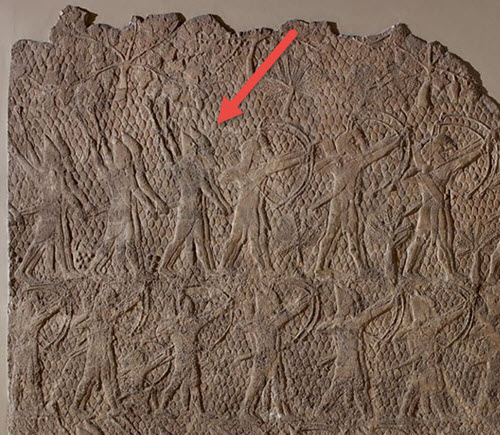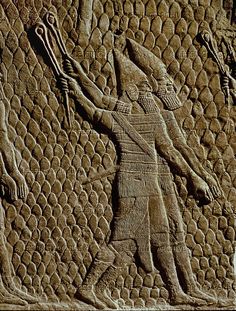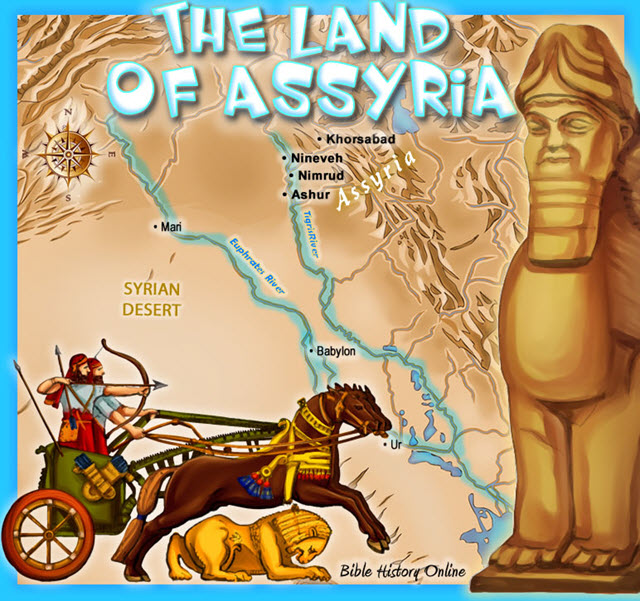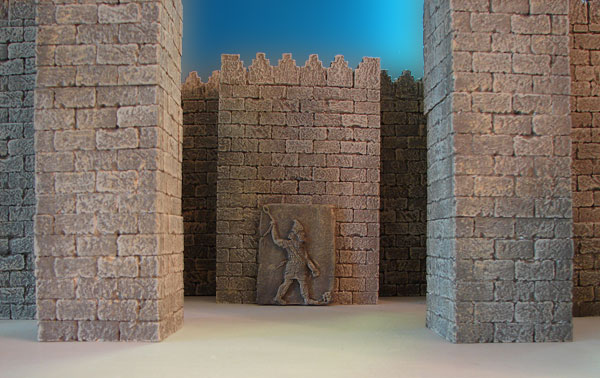|
|
|
This miniature replica is of an Assyrian
slinger or "stonethrower" from the army of Sennacherib,
King of Assyria, excavated from his palace at his ancient capital,
Nineveh. The bas-relief was discovered at the site of ancient Nineveh during the reign of
Sennacherib (705-681 BC). The original is
located at the British Museum in London. The limestone relief is a
fragment of a tablet standing over 6 1/2 feet inches tall.
2 Kings 19:16 -
LORD, bow down thine ear, and hear: open, LORD, thine eyes, and see: and
hear the words of Sennacherib,
which hath sent him to reproach the living God.

This map shows the primary capitals of the Neo-Assyrian Empire
Museum Images


Assyrian Slingers
Assyrian slingers were "stonethrowers", they would
use various pear shaped stones and sling them with leather straps or
slings. They would enter battle with the archers and the spearmen. A
good slinger could throw a stone a significant distance with amazing
accuracy.
Information about the Siege on Lachish
Relief
- Alabaster relief from the SW palace of
Sennacherib at Nineveh, his capital.
- The relief depicts Sennacherib's army storming the city of Lachish.
- The Assyrian bowmen, shield-bearers, lancers, and slingers are taking
action
- The Assyrian warriors are impaling prisoners or flaying them alive
- There is a long procession of camels and carts laden with women and
children
- Those who are not killed are being prepared for the long journey to
Assyria
- God promised Judah if they followed idols he would remove them from
the land.
- The captives are barefoot, wearing short skirted garments.
- The detailed relief stands 200 cm (6.5 feet) tall.
- Sennacherib reigned from 705-681 BC.
- The 10 northern tribes of Israel had already been taken captive to
Assyria (722 BC)
- The event took place during Sennacherib's reign.
- This wall panel is from the Neo-Assyrian Period (1000-612 BC).
- Excavated at the site of ancient Nineveh (Kuyunjik).
- Sennacherib's west campaigns extended to the land of Judah
- His army was defeated at the gates of Jerusalem by the Angel of the
Lord
- Ancient Nineveh was excavated by Austen Henry Layard of Britain around
1849.
- This stone panel is currently at the British Museum.
- Nineveh (Kuyunjik) was Sennacherib's capital city (Northern Iraq).
2 Chronicles
32:9 - After this did Sennacherib king of Assyria send
his servants to Jerusalem, (but he [himself laid siege] against Lachish,
and all his power with him,) unto Hezekiah king of Judah, and unto all
Judah that [were] at Jerusalem

Museum Excerpt
Museum number 124904
Stone panel from the SW Palace of King
Sennacherib
Kouyunjik (Nineveh), northern Iraq
Neo-Assyrian, about 700 BC-692 BC
Assault on Lachish
Gypsum wall panel relief: showing the beginning of an assault on
Lachish. At the back, long range artillery are slinging stones and
shooting arrows.
wall panel / relief
Object type: wall panel relief
Museum number: 124904
Description: Gypsum wall panel relief:
showing the beginning of the Assyrian assault on Lachish. At the back,
slingers and archers are slinging stones and shooting arrows.
Authority Ruler: Sennacherib
Culture/period: Neo-Assyrian
Date: 700 BC-692 BC
Excavated: South West Palace, Room XXXVI (OO) Panel 5 (Asia, Iraq, North
Iraq, Kouyunjik (Nineveh), South West Palace)
Materials: gypsum
Dimensions: Height: 200.66 centimetres Width: 238.76 centimetres
Thickness: 15 centimetres
Subjects: archer war siege
Associated places: Lachish (Asia, Middle East, Levant, Lachish)
Associated Event: Siege of Lachish
Excavated by: John George Taylor
Excavated by: Sir Henry Creswicke Rawlinson
Excavated by: Hormuzd Rassam
Excavated by: William Kennett Loftus
Acquisition date: 1856
Department: Middle East
British Museum Page
The Assyrian Empire
The first great military empire in ancient history
was the Assyrian Empire. By the time of Ashurnasirpal and Shalmaneser
III in the 9th century BC the Assyrians organized a mighty army of
nearly 200,000 soldiers. Their military strategy was unsurpassed up to
that time, and with the age of iron they were an unstoppable fighting
machine. They brought spearmen, archers, shieldmen, slingers, siege
engines, chariots, and a huge calvary into the battlefield. The mighty
Assyrians dominated the ancient world until they were crippled by the
God of Israel in the reign of Sennacherib. God raised up the Assyrians
to remove Israel out of his sight for their rebellion and idolatry, but
the Assyrians would also be punished also for their wicked ways. They
finally fell to the Medes and Babylonians in 612 BC and passed into
history.
 Assyrian Kings Mentioned in the Bible
Assyrian Kings Mentioned in the Bible
2 Kings 15:29 -
In the days of Pekah king of Israel, Tiglath
Pileser king
of Assyria came and took Ijon, Abel Beth Maacah, Janoah, Kedesh, Hazor,
Gilead, and Galilee, all the land of Naphtali; and he carried them
captive to Assyria.
2 Kings 15:19 - Pul the
king of Assyria came against the land, and Menahem gave Pul one thousand
talents of silver, that his hand might be with him to confirm the
kingdom in his hand.
2 Kings 18:9 -
And it came to pass in the fourth year of king Hezekiah, which [was] the
seventh year of Hoshea son of Elah king of Israel, that Shalmaneser king
of Assyria came up against Samaria, and besieged it.
Isaiah 20:1 -
In the year that Tartan came unto Ashdod, when Sargon the
king of Assyria sent him,) and fought against Ashdod, and took it;
2 Kings 19:16 -
LORD, bow down thine ear, and hear: open, LORD, thine eyes, and see: and
hear the words of Sennacherib,
which hath sent him to reproach the living God.
2 Kings 19:37 -
And it came to pass, as he was worshipping in the house of Nisroch his
god, that Adrammelech and Sharezer his sons smote him with the sword:
and they escaped into the land of Armenia. And Esarhaddon his
son reigned in his stead.
Ezra 4:10 - and the rest
of the nations whom the great and noble Asnapper brought
over, and set in the city of Samaria, and in the rest of the country
beyond the River, and so forth, wrote.
Assyrian Kings Names in Cuneiform
Archaeology
of Ancient Assyria
Timeline of Ancient Assyrian Kings
(During the Period of the Biblical Kings)
Assur-nasirpal II (885-860
B.C.) A cruel warrior king, he made Assyria into the most fierce
fighting machine of ancient world.
Shalmaneser III (860-825
B.C.) His reign was marked by almost constant war. He was the first
Assyrian king to come into conflict with Israel. King Ahab fought
against him, and king Jehu paid him tribute in 841 BC. His royal
inscriptions were more detailed and more numerous than any other king.
His building works were massive just like his father Assurnasirpal II.
See Shalmaneser
and the Black Obelisk.
Shamsi-Adad V (825-808
B.C.) Most of his reign was focused on Babylonia and his own internal
conflicts.
Adad-nirari III (808-783
B.C.) The little information about his reign mentions his building
projects at Calah and Nineveh, as well as a conflict at Der in Babylonia
and collecting tribute in Damascus, Syria.
Shalmaneser IV (783-771
B.C.) The limited knowledge of his reign reveal some conflicts in
Damascus and a period of decline in Assyria.
Assur-dayan III (771-753
B.C.) The little information about this ruler reveals Assyria being in a
period of decline.
Assur-nirari V (753-747
B.C.) There is very little information about his reign. The king of
Urartu boasted of a victory over this king of Assyria in an inscription.
Tiglath-pileser III (Pul)
(747-727 B.C.) He restored Assyria to a major world power. He is the "Pul"
mentioned in the Bible and the one who began to destroy Samaria, the
capital of the Northern Kingdom of Israel. He carried many away into
captivity. This captivity is mentioned in his own inscriptions, the
Babylonian Chronicle, and the Bible.
Shalmaneser V (727-722
B.C.) He besieged Samaria, the capital of the Northern Kingdom of
Israel. He died during the siege after imposing taxation on the holy
city (Asshur), and his son Sargon came to power.
Sargon II (722-705
B.C.) He completed the destruction of Samaria and the captivity of
Israel. He was also famous for his magnificent palace with his colossal
winged guardians.
Sennacherib (705-681
B.C.) He was the most famous of the Assyrian kings. He mentions the name
of Hezekiah on his prism during his war campaigns, he claimed to have
"Hezekiah captured in his own royal city (Jerusalem) like a caged bird."
His army was defeated at the gates of Jerusalem by the Angel of the
Lord. Sennacherib returned back to Nineveh and was killed violently by
his own son, as mentioned in the Babylonian Chronicle, The Bible, and
various other inscriptions. He also conquered Babylon.
Esar-haddon (681-668
B.C.) He rebuilt Babylon, invaded and conquered Egypt by crossing over
the Sinai Desert with Arab camels carrying water for his army, and was
one of Assyria's greatest kings. He died fighting Egypt.
Assur-banipal (668-626
B.C.) He destroyed the Thebes in Egypt and collected a great library,
innumerable clay tablets were found.
Assur-etil-ilani (626-607
B.C.) It was under his reign that the Assyrian Empire fell.
 Assyrian
annals mention contacts with some ten Hebrew kings: Omri, Ahab, Jehu,
Menahem, Hoshea, Pekah, Uzziah, Ahaz, Hezekiah, and Manasseh. Assyrian
annals mention contacts with some ten Hebrew kings: Omri, Ahab, Jehu,
Menahem, Hoshea, Pekah, Uzziah, Ahaz, Hezekiah, and Manasseh.
In the reign of Hoshea, king of Israel, Shalmaneser, king of
Assyria, twice invaded (2 Kings 17:3,5) the kingdom that remained, and
his successor Sargon II took Samaria in 722 BC, carrying away 27,290 of
the population as he tells in his Khorsabad Annals. Later Assyrian
kings, particularly Esarhaddon (681 BC - 668 BC), completed the task.
For More Info See:
Bible History Online
Map of the Land of Assyria

Kids Bible Maps
Primary Sources for Assyrian History
The Assyrian Annals. The scribes of the chief cities of the
Assyrians wrote the accounts of the king's military campaigns on
cuneiform tablets, and clay prisms or cylinders. The accounts are very
reliable, even though the accounts do not speak negatively of the
Assyrians and are meant to glorify the king. The annals also give much
detail to geography and Chronology. It is interesting how accurate the
Assyrians were with dates, they made use of an Assyrian Kings List or
the Eponym Canon.
The Assyrian Chronicles and Eponym Canon. The Assyrian scribes
organized their national events whether military, political or religious
every regnal year. The Babylonian Chronicles were structured the same
way. Assyrian records were kept very carefully, they took their dating
and their history seriously. They attached their record of events with
the solar year and with the name of an official who was known as the "limmu."
Their was a new limmu appointed every year. They recorded military,
political and religious events in every year and made references to
eclipses. The Assyrian records are highly dependable and allow Biblical
scholars a very accurate way of dating events and designating "eponyms"
for 244 year in Hebrew history, from 892-648 BC.
The Assyrian King List.
The Assyrian King List reveals a list of the kings of ancient
Assyria in chronological order, from the 2nd millennium BC to 609 BC. It
lists the name of the king, his father's name, the length of his reign,
and some great achievements.
Assyrian Sculptures. The limestone bas-reliefs discovered
from the palace walls of major Assyrian capital cities like Nineveh (Kuyunjik),
Nimrud (Calah), Khorsabad (Dur-Sharrukin), and the bronze bands on the
Balawat Gates reveal a wealth of history. The illustrative events were
carved be professional Assyrian artists like a modern day photographer
on the scene. The carvings reveal the military might and tactics of the
Assyrians, as well as the futility of those nations that defied their
might. These sculptures are on display in museums around the world, for
example: The British Museum in London, The Louvre in France, The Iraqi
Museum, and The Oriental Institute in Chicago.
The Bible. The Old Testament records the history of the Kingdoms
of Israel and Judah, along with the battles of other nations. It
includes the fall of the 10 tribes in northern kingdom of Israel in 722
BC by the Assyrians, as well as the
fall of the southern kingdom of Judah in 586 BC by Nebuchadnezzar of
Babylon. The Bible also records miraculous events surrounding people
like Elijah, and Jonah, as well as the slaying of 185,000 Assyrians at
Jerusalem by the Angel of the LORD. The events recorded in 2 Kings
generally agree with Assyrian and Babylonian sources. |






